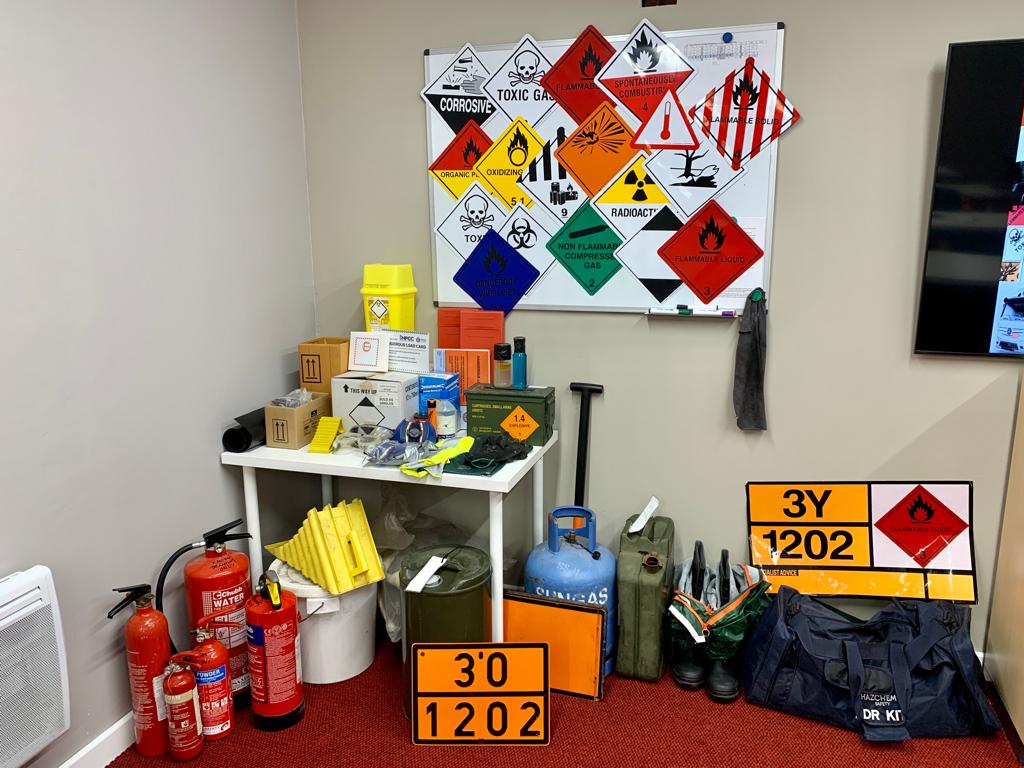What is ADR?
An ADR Licence (typically known as a Certification) is defined as the European Agreement concerning the International Carriage of Dangerous Goods by Road.
ADR is a field that requires specialist training. This certification ensures that dangerous goods being carried are in the hands of someone who understands the hazards and what to do in the situation of an incident which involves dangerous goods.
At 2 Start, we supply a range of different ADR courses at varying price points. This allows us to cater the training to your specific needs, whether you’re a driver, packer or anyone who handles hazardous goods.
Depending on your requirements, the type of training for handling hazardous goods will affect the ADR training costs you will pay for your chosen course.
What types of training are there?
There are 9 classes of dangerous goods relevant to the types of training available.
- Class 1– Explosives
- Class 2– Gases
- Class 3- Flammable Liquids
- Class 4- Flammable Solids
- Class 5- Oxidising Substances
- Class 6- Toxic Substances
- Class 7– Radioactive Materials
- Class 8- Corrosive Substances
- Class 9- Miscellaneous

Although, take into consideration that Class 1 (explosives) and Class 7 (radioactive) courses are specialist categories. You must have already completed core before you can complete one of these specialist categories.
Additionally, if you or one of your team are involved in the movement and loading of hazardous goods then our Awareness Courses will be what you require to ensure you, or your team are all competently trained with handling hazardous goods. This training is aimed at those who only move or load the goods, not the transportation of the goods.
We currently provide two course options:
The Different Types of Dangerous Goods Training 2 Start Provide
Classes 2,3,4,5,6,8 & 9
This is a five-day course. In order to complete this training, you must already have completed the Core training, and either packages, tanks or both.
Class 1 – Explosives only
This is a specialised course to give you expert knowledge to transport explosive materials.
Core, Packages & Tanks
Core will cover the foundations and fundamentals. Core will cover the foundations and fundamentals. This training must be completed in order to attend the Classes 2,3,4,5,6,8 & 9
Packages will cover transportation of hazardous goods within packaged containers.
Tanks will cover transportation of hazardous goods within tanks.
All Classes 1,2,3,4,5,6,7,8 & 9
This is a 7-day course which covers all regulations required by the appropriate organisations involved to transport ANY type of hazardous good. This course also counts towards 28 hours of your Periodic Driver CPC
Class 7 – Radioactive only
This is a specialised course to give you expert knowledge to transport radioactive materials.
Dangerous Goods Safety Advisor (DGSA)
The Dangerous Goods Safety Advisor (DGSA) course covers the required regulations that must be understood and complied with by consignors, carriers, drivers and all other staff who are involved in the road transport of dangerous goods.
2 Start also provide a Build Your Own Package. This lets you choose the training required to fit your needs.
Our training can also be provided as an off-site course if you wish to train at your own workplace.
ADR training costs will depend on your requirements, which can find out about in our other post.
Core
The core training is a compulsory requirement and must be completed with any other dangerous goods course.
This will cover the required checks, documentation and any drivers’ duties regarding the carriage of dangerous goods. Also, you will be expected to understand the law and liability of dangerous goods, and understand the importance of the regulations relevant to your organisation.
You will be expected to know all first aid and accident procedures in place, as well as knowing about the fire and personal protective equipment in the case of an incident.


Tanks
Candidates who complete dangerous goods training in tanks will only be able to transport hazardous goods in tanks such as diesel tankers transporting fuel to petrol stations. You will most likely need to require a Petroleum Drivers Passport (PDP) if you wish to become a fuel tanker driver. This is completed in-house, rather than with a training provider. This ensures that tanker drivers are “…trained and assessed in loading, transporting and offloading petroleum fuel products from road tankers.”
This will include understanding the differences between:
Your in-house training could also include you learning how holding times can differ in tanks, depending on the filling pressure and density (P.173-ADR Volume 2-2025 Edition).
- Battery-vehicles with a total capacity exceeding 1m3
- Fixed tanks or demountable tanks with a capacity exceeding 1m3
- Vehicles carrying dangerous goods in tank containers, portable tanks or MEGCs with an individual capacity exceeding 3m3 on a transport Unit
Packages
The training will cover the transportation of dangerous goods in packages. This will only let an individual transport hazardous goods within packaged containers. For example, carrying a load containing boxes of batteries.
You will be given a thorough understanding on how packaged dangerous goods should be labelled. You will also learn the correct and safe way dangerous goods should be packed.
Also, you may also be instructed to reference the ADR Volume Books (also known as the orange books) which will provide up to date information for ADR classifications, cores, packages and tanks.
Taking a course at 2 Start will give you extensive knowledge and skills on how to deal with dangerous substances, enabling you to achieve your certification.

Who needs ADR training?
In short, those who are involved with the process of the carriage of dangerous goods will require some form of training, but won’t need the full certification. From those who package hazardous substances, to the forklift drivers who transport the goods from the warehouse to the truck.
If you wish to transport dangerous goods in any vehicle, you will need the required certification. You will NOT need the certification if any of the following apply to you.
- Your load is below the threshold limits
- Dangerous goods are packed in limited quantities
- Dangerous goods are packed in expected quantities
The ADR Volumes 1 & 2 (2025) give all information needed about threshold limits and exceptions.
What Job Opportunities are there?
Depending on the training classes completed, there is an array of vacancies in relation to your career opportunities.
One example is if you complete a class 3 course, you could look at becoming a tanker driver.
As of April 2025, Glassdoor Salary Checker states that a tanker driver can see a salary as high as £41,000!
Although, in this instance, you would have to ensure you have a Heavy Goods Vehicle (HGV) licence.
It must be considered that if you want to carry dangerous goods, your vehicle MUST COMPLY with ADR ANNEX B.
This reinforces the notion that the category of vehicle you are using to transport hazardous goods is not as important as your vehicle (irrespective of category) is compliant with ADR ANNEX B.

Once the required training is completed, you will receive your vocational certification. This will open up opportunities for other vacancies, permitting you have the required training.
If you are planning on driving/transporting hazardous substances by vehicle then you will need the relevant licencing for the vehicle in which you are going to drive. This is in addition to your certification.
For instance, if you need to carry dangerous goods in a 7.5 tonne van, you need a Category C1 licence.
If you wish to drive for hire and reward, then Driver CPC will also be required. This is also in addition to your licence and your certification.
Experience is good, but having your full certification is best!
A lot of HGV and ADR jobs will require the ADR certification in this field. Additional in-house product training will typically be provided by the employer. The more experience you have, the more likely you’ll be considered for the higher-demanding and specialist classes.
This is because training, especially in a highly skilled job role as a dangerous goods driver, certifies to employers (both current and perspective) that you are qualified in the transportation of hazardous goods, safely and within compliance of the regulations.
Investing in your training, and upskilling yourself and staff, is important when looking to increase your earning potential.
2 Start would recommend you undertake retraining no later than 2 months (6-8 weeks) prior to your certification expiration date (typically your certification is valid for five years).
However, you can begin to refresh your training within the last 12 months before your certification expiration date.

Upon successful completion and passing your examination, you will then be a certified dangerous goods driver. You will receive a driver card, shortly after. Typically, within 28 working days.
It is important for you to remain compliant when keeping your certification current. By doing this, you will be keeping up to date with new technology and legislative changes.
Help increase the safety of you, other road users, and those around you when transporting hazardous goods by road.
Career Progression
Considering your options after successfully passing your vehicle licence and ADR certification(s) raises the question of what you could do next?
You can train to become a Dangerous Goods Safety Advisor (DGSA), which helps other businesses keep safe and secure when dealing with dangerous goods.
- Obtain a vocational training certificate after receiving appropriate training
- Pass a written examination (This exam is approved by the Department for Transport (DfT))
After you have completed your DGSA examination and training, your DGSA certification will be valid for five years.
A DGSA must be appointed if there is undertaking that consigns, transports, packs, fills, loads or unloads dangerous goods regularly by road, rail or inland waterway.
The appointed DGSA must be apparent at an organisation if you transport dangerous goods, unless and of the following exemptions apply:
- You only do it occasionally, for example breakdown recovery vehicles
- You’re only receiving the dangerous goods (you’re the ‘consignee’)
- The dangerous goods are in ‘limited quantities’
- Dangerous goods are being moved very short distances by road, for example between buildings on an industrial estate
- You’re using private vehicles
Not only are the benefits of completing ADR training vast, such as increasing knowledge and being certified in certain types of classes. But you can also advance your search of new career opportunities, as many employers and organisations are more likely to choose a candidate if they have the needed certification for a job role.
2 Start can provide both driver training and ADR training, so that you can upskill you or your workforce.



Leave a Reply